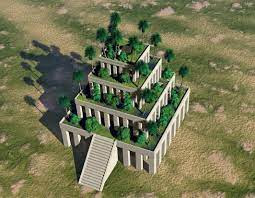The Hanging Gardens of Babylon
The Hanging Gardens of Babylon is considered one of the Seven Wonders of the Ancient World, although its existence has been debated by historians and scholars. According to legend, the gardens were built in the city of Babylon, located in modern-day Iraq, by the Babylonian king Nebuchadnezzar II in the 6th century BCE. The gardens were said to be a lush oasis in the desert, featuring a variety of plants, flowers, and trees arranged in terraces that rose above the city.
The Hanging Gardens of Babylon were believed to have been constructed using a sophisticated system of irrigation and engineering that allowed water to be transported from the Euphrates River to the top of the gardens. The gardens were also said to have included a complex system of pumps and water wheels that helped to distribute water throughout the terraces.
Although there is no archaeological evidence to prove the existence of the Hanging Gardens, ancient texts and accounts suggest that they were a marvel of engineering and design. The Greek historian Diodorus Siculus described the gardens as "a work of art of royal luxury and immense size." The historian Philo of Byzantium also wrote about the gardens, noting that they contained exotic plants and trees from all over the world.
The Hanging Gardens of Babylon were said to have been built by Nebuchadnezzar II as a gift to his wife, Queen Amytis of Media, who was said to have been homesick for the green hills of her homeland. The gardens were said to have been one of the greatest wonders of the ancient world, attracting visitors from all over the known world. However, the gardens were destroyed by invading armies in the 2nd century BCE, and their location and exact appearance remain a mystery.
Despite the debate surrounding the existence and location of the Hanging Gardens of Babylon, they continue to capture the imagination of people around the world. The gardens have been the subject of numerous works of literature, art, and popular culture, and their legacy lives on as a testament to the beauty and ingenuity of ancient civilizations.
